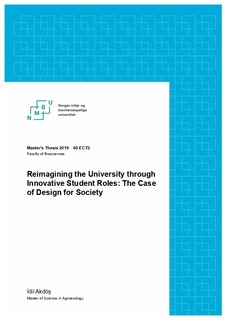| dc.description.abstract | Student-centred learning is a paradigm shift, which centralises the needs and learning interests of students and explores student’s active learning and involvement in the learning process. While this approach positions the student’s role as learner, students can act in different roles other than as learners in partnership with faculty. This Action Research studies student-centred learning and student-faculty partnership in the case of Design of Society which was an interdisciplinary student-driven course in Spring 2019 at the Norwegian University of Life Sciences (NMBU), planned and implemented by three students who acted as Course Coordinators. The objective of the research is to determine the supporting and hindering forces that act on interdisciplinary student-driven education in terms of these approaches, and to explore which possibilities might elevate such an educational model, using Design for Society as a case. I collected data primarily through semi-structured interviews and used content analysis to discover themes to inform my objectives. My findings imply that institutional, structural and motivational supporting factors are crucial in establishing interdisciplinary student-driven education, despite the presence of limitating institutional, financial, structural and motivational elements. Other findings imply that Design for Society offered various elements of studentcentred learning in its approach and innovated a role that can be considered student-as-partner. While this role problematized the distinction between the student and the teacher, overall it led to increased confidence and agency, as other studies suggest. Other higher education institutions can draw from these findings and assess their educational environment in terms of this study’s findings. Possibilities show various pathways to establish an enabling environment and partnership models that might further facilitate student-centred learning environments and nurture student-driven education. Further research is needed to explore ways to deal with these limiting factors and ways of enhancing supporting factors. Additionally, research should take a closer look at different types of student-faculty partnerships and empowered student roles in different contexts. | nb_NO |

